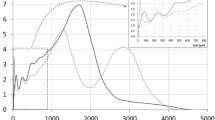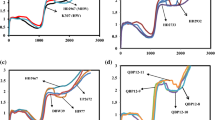Abstract
The objective of this study was to determine the possibility of using Mixolab® to predict the cookie baking quality of different wheat flours. Mixolab data was also compared with various flour quality characteristics. There were significant correlations (P < 0.001) between Mixolab stability and some of the flour quality characteristics (protein and wet gluten contents, Zeleny sedimentation value). Alveoconsistograph T value was negatively correlated with Mixolab C3, C4 and C5 values. The cookie diameter gave highly significant correlations with protein content, Zeleny sedimentation value and damaged starch content. Mixolab C3 and C4 values were highly correlated (P < 0.001) with both cookie diameter and spread ratio. A significant correlation coefficient (r = 0.556) was determined between the cookie diameter and C1–C2 value which is an indication of protein quality. The dependence of cookie diameter and spread ratio on Mixolab C3 value, damaged starch content and Zeleny sedimentation value were analyzed with multiple regression analysis and high multiple correlation coefficients were found between these parameters (r = 0.948 and 0.861, respectively).

Similar content being viewed by others
References
Bloksma AH, Bushuk W (1988) Rheology and chemistry of doughs. In: Pomeranz Y (ed) Wheat: chemistry and technology, 3rd edn, vol II. AACC, St Paul, pp 131–218
Sliwinski EL, Kolster P, van Vliet T (2004) J Cereal Sci 39:231–245
Anonymous (2005) Mixolab® user’s manual. Tripette & Renaud Chopin, France
Manthey F, Tulbek MC, Sorenson B (2006) AACC annual meeting: World Grain Summit: foods and beverages, 17–20 Sep 2006, San Francisco, CA, p 336
Kahraman K, Sakiyan O, Ozturk S, Koksel H, Sumnu G, Dubat A (2008) European food research and technology. doi:10.1007/s00217-007-0757-y
Rosell CM, Collar C, Haros M (2007) Food Hydrocolloid 21:452–462
Tulbek MC, Hall C (2006) AACC annual meeting: World Grain Summit: foods and beverages, 17–20 Sep 2006, San Francisco, CA, p 140
Bonet A, Blaszczak W, Rosell CM (2006) Cereal Chem 83:655–662
AACC (2000) Approved methods of the AACC. American Association of Cereal Chemists, St. Paul, MN
Hoseney RC (1994) Principles of cereal science and technology. American Association of Cereal Chemists Inc, St Paul, MN
Finney KF, Yamazaki WT (1967) Quality of hard, soft and durum wheats. In: Quinsberry KS, Reitz LP (eds) Wheat and wheat improvement. American Society of Agronomy Inc., Madison, WI, pp 471–503
Acknowledgments
We would like to thank Chopin Technologies for lending us the Mixolab® instrument.
Author information
Authors and Affiliations
Corresponding author
Rights and permissions
About this article
Cite this article
Ozturk, S., Kahraman, K., Tiftik, B. et al. Predicting the cookie quality of flours by using Mixolab® . Eur Food Res Technol 227, 1549–1554 (2008). https://doi.org/10.1007/s00217-008-0879-x
Received:
Revised:
Accepted:
Published:
Issue Date:
DOI: https://doi.org/10.1007/s00217-008-0879-x




